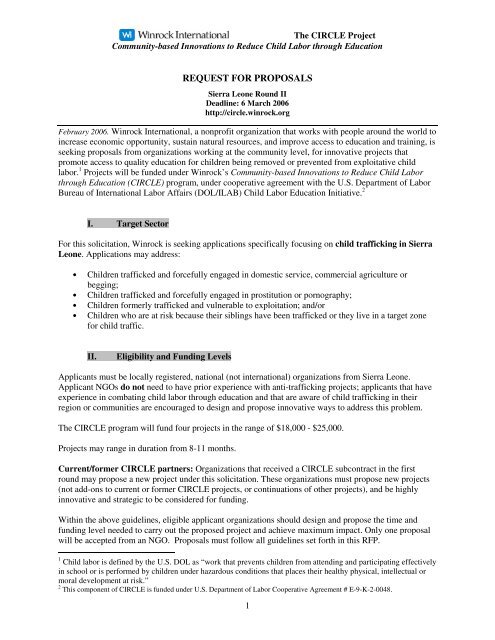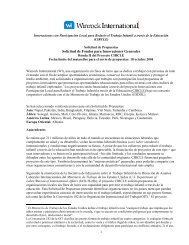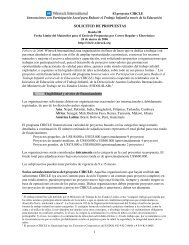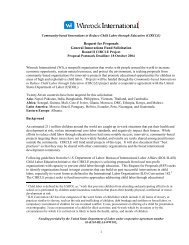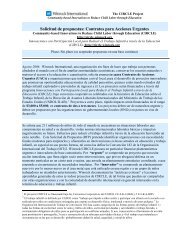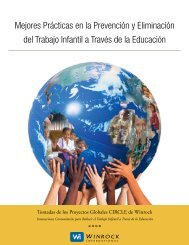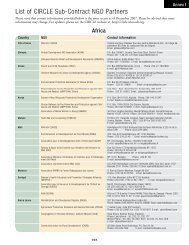Sierra Leone 2006 - CIRCLE - Winrock International
Sierra Leone 2006 - CIRCLE - Winrock International
Sierra Leone 2006 - CIRCLE - Winrock International
Create successful ePaper yourself
Turn your PDF publications into a flip-book with our unique Google optimized e-Paper software.
The <strong>CIRCLE</strong> ProjectCommunity-based Innovations to Reduce Child Labor through EducationMinimum Qualifying CriteriaThe applicant organization must meet the following minimum criteria:• Be a nationally-based (not international), non-governmental organization registered according to<strong>Sierra</strong> <strong>Leone</strong> laws and legislation (faith-based groups are eligible and encouraged to apply);• Demonstrate ability to manage subcontracts in a sound manner (such as a bank account and anexperienced accountant);• Demonstrate technical knowledge, capacity, and relevant experience to address child labor, childtrafficking and education issues, and have concrete systems to monitor impact;• Submit a complete application with a project description that promotes <strong>CIRCLE</strong> objectives; and• Bring not less than 10% (out of the total budget amount) in contribution of matching funds orassets to the project proposed.<strong>Winrock</strong>’s <strong>CIRCLE</strong> program will not fund:X Government agencies, political organizations, or organizations that lobby the U.S. government;X Activities that create profit for an organization, or any income generating activities;X More than 10% of the total budget proposed for construction expenses;X Equipment that is not explicitly required to complete the work outlined in the proposal; 3X Personnel or administrative expenses that are not related to the project; orX Activities financed by other U.S. Government sources or that duplicate other U.S. DOL funding.DOL funded community-based NGOs are eligible under <strong>CIRCLE</strong> to propose innovative newprojects that have synergies with other projects but that do not duplicate or add to them.In addition, <strong>CIRCLE</strong> subcontractors may not further subcontract any work to another organization.Micro-finance or income generating activities may be conducted by the NGO to complement thoseactivities proposed under <strong>CIRCLE</strong>, but must be funded from other sources.III.Technical Context, Objectives, and ImpactA. ContextAn estimated 211 million children around the world are caught up in work situations that put their healthand development at risk, violate international core labor standards, and negatively impact their futures.While efforts to reduce child labor through education have had some notable success, innovative,community-based projects targeting these issues have not been widely funded, and results are rarelyshared among practitioners outside the community. <strong>CIRCLE</strong> funds small projects of this type. <strong>Winrock</strong>will also document the “best practices” of funded projects so that they may be shared by U.S. DOL withother community-based organizations and the broad international development community.Following guidelines from the U.S. Department of Labor/ Bureau of <strong>International</strong> Labor Affairs(DOL/ILAB) Child Labor Education Initiative, the <strong>CIRCLE</strong> project is soliciting proposals from <strong>Sierra</strong><strong>Leone</strong>an non-profit organizations with capacity to prevent child labor through education. This Requestfor Proposals (RFP) seeks to identify organizations that can build on past successful interventions orpropose pilot initiatives to reduce or eliminate child labor; especially child trafficking, one of its worstforms as defined in the <strong>International</strong> Labor Organization (ILO) Convention 182. 4 The <strong>CIRCLE</strong> project3 If awarded a subcontract, the organization must follow U.S. government procurement regulations.4 ILO Convention 182 lists four categories of the worst forms of child labor: 1) all forms of slavery, such as the sale andtrafficking of children, debt bondage and serfdom or forced labor, or compulsory recruitment of children for use in armedconflict; 2) use, procurement or offering of a child for prostitution or pornography; 3) use or procurement of a child for illicitactivities; and 4) work which by its nature or circumstances is likely to harm the health, safety, and morals of children.2
The <strong>CIRCLE</strong> ProjectCommunity-based Innovations to Reduce Child Labor through Educationspecifically seeks to fund innovative approaches that have a grassroots connection to children, teachers,parents, and local communities. By “innovative” we mean an approach that is new (or at least new to thetarget area), that targets a previously un-served region or group of child laborers, or that seeks to arrangeadvocacy at a critical time in a region or country. Projects that are especially innovative in their approachwill receive the highest priority for funding.All projects must have a clear educational component (direct or indirect), and at the same time be able toclearly monitor the removal of children from harmful child labor.B. Child Trafficking in <strong>Sierra</strong> <strong>Leone</strong> 5The massive displacement of youth and the destruction of educational facilities during the war make<strong>Sierra</strong> <strong>Leone</strong>an children especially vulnerable for trafficking, notably in the border areas and former warzones. The borders tend to be insufficiently protected and are subject to intensive illegal trade in weapons,diamonds, sex, drugs, and persons. Families are still disrupted, and children are still traumatized andstigmatized (especially the former “soldiers’ wives,” now teenage mothers). With more than half of allschools destroyed, youth lack opportunities to prepare for their future. Former child soldiers who werepromised rehabilitation are often disillusioned because programs fail to address their needs. Moreover,girls tend to be given into marriage at a very early age, and look for opportunities to escape. Children inthese situations are easily lured into trafficking schemes from which it is hard to get away. TheGovernment of <strong>Sierra</strong> <strong>Leone</strong> has recently passed the Anti-Human Trafficking Act, which defines humantrafficking as an offense and criminalizes it in all forms.<strong>Winrock</strong> <strong>International</strong> seeks to address these worst forms of child labor, (both the prevention of childtrafficking and the reinsertion of trafficked children) through innovative interventions aimed at education.C. <strong>CIRCLE</strong> Project ObjectivesOrganizations must choose one of the following as their project’s primary objective. Under thissolicitation, projects addressing objectives 1 or 2 (below) will receive higher priority among similarlyscoredproposals. (See page 6 for evaluation criteria and scoring.) Additionally, organizations mustspecify not only how the project will impact the primary objective, but also if and how it will contributeto any of the other three objectives. Projects do not need to contribute to all of the objectives.1. Strengthen national institutions and policies on education and child labor. Sample activitiesmay include training and establishing dialogue with public officials, local leaders, law makers,and enforcement agencies on the hazards of child trafficking and the benefits of education;establishing local committees to increase vigilance regarding trafficking and child labor;promoting development of public programs to improve access to school, by offering alternativessuch as vouchers, scholarships, and apprenticeships; developing materials and guidelines forimproved enforcement and monitoring methods for ensuring that children removed from work areplaced in and remain in educational settings.5 This summary is based on <strong>Winrock</strong>’s on-the-ground observations in <strong>Sierra</strong> <strong>Leone</strong> and on the following sources:Network Movement for Democracy and Human Rights, NMDHR (July 2005) ‘Draft Report on the Assessment Surveyon Human Trafficking in Kailahun District.’Peters, Krijn (2004) ‘Re-examining Voluntarism. Youth Combatants in <strong>Sierra</strong> <strong>Leone</strong>.’UNICEF (August 2005) Press communique: ‘<strong>Sierra</strong> <strong>Leone</strong> signs anti-trafficking act,’ Alison Parker.3
The <strong>CIRCLE</strong> ProjectCommunity-based Innovations to Reduce Child Labor through Education2. Ensure the sustainability and/or replicability of efforts to reduce child labor and childtrafficking through education, as documented by monitoring impact, including numbers andstories that reflect educational persistence and prevention of child labor. Sample activities mayinclude innovative child-to-child methods for tracking children; collaboration with localauthorities for intercepting child traffic and the reinsertion of trafficked children in school;parent-teacher focus groups to check frequently on the presence or absence of the child in school;peer pressure teams developed at community level to keep records on attendance and trackingincentives.3. Strengthen formal, non-formal, and transitional education systems that encourage childlaborers, and those at risk of trafficking, to attend school. Sample activities may include teachertrainings on the hazards of child trafficking; proposals by community groups to support teachersin activities and/or for supplies to improve quality and relevance of teaching; vocational andinformational technology training; labor market studies, apprenticeships, or school-to-workprograms; health interventions that directly impact a working child’s school attendance andperformance; engendering voluntarism and student community participation; or alternativerelevant curriculum that provides basic skills and education for at-risk children, drop outs, andchildren in work situations.4. Raise awareness of the hazards of child labor and child trafficking and the importance ofeducation for all children. Sample activities may include creative use of media, teacher training,mentoring of youth, theater, art, curriculum development for schools, use of the internet,community focus groups, civil society groups, seminars, workshops, and town meetings. Allawareness raising activities should be able to establish a link with and document reduction ofchild trafficking and increased enrollment and/or retention of children in school.These suggested activities are not exhaustive and organizations are encouraged to suggest otherinnovative approaches that fall within the four broad categories.Once the organization has identified its objective(s), the program approach, activities, and timeline shouldbe developed. Please see the “Full Proposal Outline” in Section I of the application, below, for all sectionsto be included in the <strong>CIRCLE</strong> proposal.D. Monitoring and Evaluating ImpactSince ensuring positive results for children and communities is the goal, monitoring and evaluation is acentral part of the <strong>CIRCLE</strong> project vision. <strong>Winrock</strong> requires all subcontractors to submit a project withclear objectives and measurable indicators of impact, which confirm the achievement of these objectives.The requirement for careful planning and monitoring aims to encourage organizations to betterunderstand their project’s design, document its accomplishments, improve management and decisionmaking.The <strong>CIRCLE</strong> project requires applicants to submit a Logical Framework and a Monitoring andEvaluation (M&E) Plan.The purpose of the Logical Framework is to assist with project design and ensure that there are clear anddirect linkages between the <strong>CIRCLE</strong> goal, the project’s objective(s), and all proposed activities. Oncethese relationships are defined, the M&E Plan lays out the NGO’s specific impact targets and describeshow they will conduct data collection, processing, and analysis as the means to document impact,experiences, and best practices. Please see Appendix I of this RFP for <strong>CIRCLE</strong> templates for theseimportant pieces of the project design.4
The <strong>CIRCLE</strong> ProjectCommunity-based Innovations to Reduce Child Labor through EducationDirect assistance. While each project will have its own unique indicators to measure success, all<strong>CIRCLE</strong> projects must track common indicators when implementing direct assistance activities. For thepurposes of <strong>CIRCLE</strong> projects, “direct assistance” activities are any school enrollments (into formal, nonformal,or alternative programs), school assistance (such as provision of scholarships or supplies), orother actions that lead directly to children leaving labor and entering school (such as building or repairingclassrooms).If an NGO’s proposed project is undertaking any of these activities, the NGO must have or design waysto verify progress toward the following common impact indicators:• Withdrawn or prevented: Children are prevented or withdrawn from exploitative child labor(according to international and national standards), and are provided with education or trainingopportunities as a result of the project• Retention: Children are retained in educational programs as a result of the project.• Completion: Children complete educational programs as a result of the project.In order to verify progress toward these indicators, NGOs must have systems for monitoring thosechildren who benefit from their project’s direct assistance activities (as defined above). For example, if achild was formerly working full-time and is now enrolled in a <strong>CIRCLE</strong>-funded vocational and literacyprogram, the NGO must be able to verify (to the best of its ability) that that child is no longer working, oris working only under nationally sanctioned labor standards (i.e. no more than four hours per day for achild under 16 years old). <strong>CIRCLE</strong> proposal evaluators will be asking the questions: does the NGO knowand strive to achieve national or internationally accepted standards regarding acceptable child work?What monitoring systems does the NGO have to attest that its proposed <strong>CIRCLE</strong> beneficiaries will nolonger be in the worst forms of child labor?Other actions/forms of assistance. In addition to tracking direct or indirect linkages to one or more ofthe three common indicators described above (if relevant), each subcontractor will be required to identifytheir own indicators that relate directly to performance and success of the proposed project.After award, <strong>CIRCLE</strong> subcontractors will be required to submit baseline data for each approved indicator,and will submit bi-monthly targets (or goals) for achievements toward each indicator over the duration ofthe project. Subsequently, NGOs will report actual data totals to <strong>Winrock</strong> on a bi-monthly basis. All dataon children must be disaggregated by male and female.IV.Proposal Review, Evaluation Criteria, and AwardsAll proposals should follow the Technical Proposal outline in Section I of the proposal format, on page 9.There will be three stages of proposal review:Stage 1:Pre-Qualification Review: Each proposal is screened to ensure that each of thenecessary components has been submitted. Failure to submit a completedapplication will disqualify an organization’s application.Stage 2:Stage 3:Executive Summary Review: Based on an initial review of this summary, adecision will be made as to whether to evaluate the full proposal. The full selectioncommittee will only review an NGO’s full proposal if the Executive Summary provesthat it is it innovative and meets the objectives of <strong>CIRCLE</strong>.Full Proposal Review: The full proposal will be judged (by an independentcommittee) on the basis of the following weighted criteria, for a total of 100 points.5
The <strong>CIRCLE</strong> ProjectCommunity-based Innovations to Reduce Child Labor through EducationInnovation. The organization proposes something new, unique, or otherwiseinnovative, and can clearly describe how and why they are trying somethingdifferent. (10 points)Project approach and objectives. Clear explanation of how the project will contributeto meeting <strong>CIRCLE</strong> project objectives. Clear description of activities and obviouslinkages between those activities and the project’s objectives. Reasonableimplementation timeline. (20 points)Budget. Proposed budget is efficient, realistic, and clearly linked to the projectapproach, and includes reasonable match/cost-share (20 points)Organizational experience and capacity. The NGO’s professional experience anddemonstrated record of success related to the activity (15 points; less than 8 pointswill rule out a candidate. See Section II, Questionnaire, for more detail on thiscriterion)Monitoring and evaluation. Feasibility and innovativeness of an organization’sLogical Framework and M&E Plan (15 points)Community and child-centered focus. Evidence of inclusion of communities andchildren in the decision-making process on proposals that directly affect them; i.e.,community and child participation (10 points)Sustainability. Plans and prospects for sustaining some or all of the project’scomponents after <strong>CIRCLE</strong> funding ends (10 points)Notification and Deadlines<strong>Winrock</strong> <strong>International</strong> will notify organizations regarding the status of a proposal within 45 days of thereceipt of the proposal. <strong>Winrock</strong> has the right to reject any and all proposals based on the qualificationsoutlined in this document.Regional Launch MeetingRepresentative(s) from NGOs that are awarded a <strong>CIRCLE</strong> subcontract will be required to attend aRegional Launch Meeting (RLM). The RLM will be funded by the <strong>CIRCLE</strong> project at no cost tosubcontracting organizations. The RLM will take place within one month of project awards, and beforeproject signing and start-up, in order to establish a solid and cohesive relationship between <strong>Winrock</strong> andall new <strong>CIRCLE</strong> implementing organizations in <strong>Sierra</strong> <strong>Leone</strong>. The RLM will provide a forum fordiscussing the work plans of each project, as well as all of the requirements and procedures (financial andadministrative, monitoring and evaluation, reports and documents) of the <strong>CIRCLE</strong> project. This meetingwill take place in May <strong>2006</strong> in Freetown.Submission of Applications and Official LanguagesSpecific instructions for proposal submission are included on page 8. As English is the official workinglanguage of the <strong>CIRCLE</strong> project, organizations are requested to submit their applications in English.Submission DeadlinesTWO hardcopies of the completed applications must be postmarked by 06 March <strong>2006</strong> and received atthe <strong>CIRCLE</strong> Regional Office no later than 15 days after the deadline, 21 March <strong>2006</strong>.6
The <strong>CIRCLE</strong> ProjectCommunity-based Innovations to Reduce Child Labor through EducationOrganizations must also submit an electronic version via e-mail with a subject line including the NGOname and “<strong>CIRCLE</strong> proposal,” with the full proposal attached in Word or PDF format, no later than 06March <strong>2006</strong>.Please use the street and e-mail addresses provided below:<strong>Winrock</strong> <strong>International</strong> MaliSaskia Brand, DRMHamdallaye, ACI 2000BP: E-825BamakoMaliEmail: sbrand@winrock-mali.org7
The <strong>CIRCLE</strong> ProjectCommunity-based Innovations to Reduce Child Labor through EducationINSTRUCTIONSIn submitting a proposal, all applicants are required to submit:1) A duplicate Cover Sheet (provided below) attached to both the Technical (Section I) andQuestionnaire (Section II) components of the proposal.2) Section I: Technical proposal and Budget3) Section II: Financial questionnaire4) Appendix I: Logical Framework and M&E PlanThe technical section will be scored separately from the financial section. Only one proposal per NGOwill be considered under the <strong>CIRCLE</strong> project.COVER SHEETThe following cover sheet should accompany all pieces of the complete application (so please copy andinsert at the beginning of each file attachment or separate proposal piece).Proposal Title:Country:Funding amount requested:Length of proposed project:Primary Objective: (identify only one out of the four <strong>CIRCLE</strong> project objectives):Name of organization:Contact Person # 1 (with title and e-mail address):Contact Person # 2 (with title and e-mail address):NGO phone/fax numbers:Street address:City:State/County:Postal code:8
The <strong>CIRCLE</strong> ProjectCommunity-based Innovations to Reduce Child Labor through Education<strong>CIRCLE</strong> Subcontract Proposal, <strong>2006</strong>SIERRA LEONESection I: TECHNICAL PROPOSAL & BUDGETMust be completed in EnglishOrganizations submitting a technical proposal must follow the outline below in order to be considered.Proposals must clearly demonstrate the organization’s ability to manage and implement a program thatcorrelates directly to one of the four main objectives of the <strong>CIRCLE</strong> project, as described in the RFP.Full Technical Proposal Outline Note: the total of sections 1-4 must not exceed 17 pages1. Coversheet (1 page, form provided in RFP)2. Executive Summary (2 pages. Must be in English)3. Project Narrative (maximum 12 pages)a. Background and rationale: why is the project needed? Who are your target beneficiaries,and what sectors of child labor are you addressing? Also, what are the national andinternational standards for child work that you are you aware of and responsive to?b. Description of innovation: how is the project new and different?c. Objectives, and planned activities to contribute to the objectivesd. Community and child-centered focus: how are stakeholders integrally involved?e. Implementation plan and timeline: how will you complete the activities described?(Exactly what resources and staff are needed?) When will you conduct or complete eachactivity? (Please plot all project activities across the total proposed length of the project.)f. Sustainability and Expected Outcomes: will some or all of the project components besustainable after <strong>CIRCLE</strong> funding ends? Also, please summarize (in narrative or in atable) the numbers and types of beneficiaries your project will reach.4. Institutional Experience and Capabilities, and proposed management and staff for the project(maximum 2 pages)5. Budget. Organizations must contribute 10 % in match contributions to their proposed project. Asample budget and description of types of match is provided below.6. Appendix I: Logical Framework and M&E Plan. Please see the samples provided.FormattingOrganizations must use the following formatting requirements for proposals:• 8 ½ x 11 inch size or A4 size white paper;• 10-12 point Times New Roman font size;• Double-spaced; and• 1-inch margins.Proposals that do not meet these formatting requirements will not be considered for review.9
The <strong>CIRCLE</strong> ProjectCommunity-based Innovations to Reduce Child Labor through EducationBudget TemplatePlease note this is a budget template only, and applicants may add or delete items as relevant to theoperation of the proposed project. NGOs should maintain the section headings, including Salary andWages, Benefits, Procurement, Travel and per diem, Project Activities, and Other Direct Costs, but maycustomize the line items to the proposed project. Administrative costs, which include line items I, II, IVand V, in sum must not be more than 35% of the total budget.The budget must be presented in <strong>Leone</strong>s and U.S. Dollars.Line ItemsUnitsUnit Cost,<strong>Leone</strong>sUnit Cost,USD ($) Total Amount ($)I. Salary and WagesProject DirectorProject ManagerII. Travel and Per DiemIII. Project ActivitiesIV. Other Direct CostsRentElectricityPhoneInternetV. Indirect Cost RateSub-total:Total Estimated Costs:Match ContributionsItem1.2.3.Grand Total:Total AmountGuidelines:1. “Units” may be for example the number of months (for staff’s salaries, rent, etc.) or the numberof items (for supplies, trainings, etc.).10
The <strong>CIRCLE</strong> ProjectCommunity-based Innovations to Reduce Child Labor through Education2. Salaries should be based on a staff person’s total annual rate, with a certain number of units(months or weeks) charged to the proposed project. Consultants may be budgeted in days, weeks,or months, as appropriate.3. Fringe benefits may be charged in proportion to staff time or may be counted as match to theproject (see below): in any case, NGOs must show that they are in compliance with <strong>Sierra</strong> <strong>Leone</strong>regulations regarding provision of fringe benefits (i.e. employee social contributions, leave time,and others) for staff.4. Travel costs directly relevant to project implementation may be budgeted. Airfares may beeconomy class only. Per diem payments may not exceed those approved by the U.S. Government.5. NGOs will need to open and maintain a separate bank account for <strong>CIRCLE</strong> and should budget forany anticipated bank fees.6. NGOs will be required to send reports/receipts to <strong>Winrock</strong> every-other-month, and may do thiseither via DHL or other secure mail service, OR by scanning and e-mailing all documents. NGOsshould budget for either DHL costs or for a basic scanner if necessary.7. Organizations are encouraged to budget for translation expenses if relevant to their project.8. VAT taxes cannot be included in the budget, but can be considered as match.Match Funding Policies and ProceduresSince the <strong>CIRCLE</strong> project is funded by the U.S. Government, it is subject to its financial rules under theCode of Federal Regulations (CFR). Match is referred to as any project or program costs not borne by theU.S. Federal Government. There are several types of match that can be provided, including volunteerservices furnished by professional and technical personnel, consultants and other skilled and unskilledlabor that may be counted as cost sharing or matching if the service is an integral and necessary part of anapproved project or program, in-kind donations, and other direct funding from the subcontractor.The following basic requirements must be met in order for contributions to be considered as match:• Verifiable from the recipient’s records.• Not included as contributions for any other U.S. federally-assisted project or program.• Necessary and reasonable for proper and efficient accomplishment of project or programobjectives.• Allowable under the applicable cost principles.• Not paid by the U.S. Federal Government under another award, except where authorized byFederal statute to be used for cost sharing or matching.• Provided for in the approved budget.• Conform to other provisions of CFR Section 226.23 Cost Sharing or Matching, as applicable. 66 Please see the following website under the section titled, Cost Sharing or Matching, for the full text of all requiredconditions. .11
The <strong>CIRCLE</strong> ProjectCommunity-based Innovations to Reduce Child Labor through Education<strong>CIRCLE</strong> Subcontract Proposal, <strong>2006</strong>SIERRA LEONESection II: FINANCIAL QUESTIONNAIREMust be completed in EnglishThis financial and administrative component is designed to determine the ability of the organization to manage aproject, and a programmatic technical component to outline the programmatic and budget activities. As acomponent of the RFP, prospective organizations must provide financial and administrative informationconcerning their management policies. This information assists <strong>Winrock</strong> <strong>International</strong> in determining themanagement capabilities of an organization and remains confidential. This score for measuring institutionalcapacity will be largely based on the content of the questionnaire. This section is scored separately from thetechnical section of the application.SubContract Questionnaire for Applicants(Please attach copies of Registration Documents)Section A: General InformationLegal Name of Organization: ____________________________________________Contact Person: ______________________________________________________Mailing Address:______________________________________________________Street Address (if different than above): ____________________________________Telephone Number: __________________________Facsimile Number: ___________________________E-mail Address: _____________________________Website Address: ____________________________1. What type of organization are you? (check all that apply)ProfitNGONon-ProfitGovernmentalOther (please explain) _________________________________2. Is your organization legally registered? No YesIf yes, when and where was your organization registered?
The <strong>CIRCLE</strong> ProjectCommunity-based Innovations to Reduce Child Labor through Education_______________________________________________________________Please provide a copy of your organization’s registration certificate.EnclosedNot enclosed (please explain)_______________________________________________________________3. What is your organization’s tax status?ExemptNon-ExemptPlease indicate your tax ID number: __________________________________4. Is your organization affiliated with any other organization?NoYes (please explain)________________________________________________________________5. Please list the names of the following individuals (provide an organizational chart if possible):Chairman ___________________________________President/Executive Director: ________________________________Chief Financial Officer: _____________________________________Bookkeeper/Accountant: ____________________________________Treasurer: ___________________________________Secretary: ___________________________________Section B: Financial Information1. Enter the beginning and ending dates of your organization’s fiscal year:From (month/day): ________________ to (month/day): ___________________2. Please complete the requested information (provide a copy of your most recent financial reports):Current year information (indicate period): _________________Revenues: _______________________ in local currency
The <strong>CIRCLE</strong> ProjectCommunity-based Innovations to Reduce Child Labor through EducationExpenses: _______________________Assets: _________________________Liabilities: _______________________Prior year information (indicate period): _____________________Revenues: _______________________Expenses: _______________________3. Of your current year funding, how much comes from the following sources:U.S. Government Funds (*) _________________________________National/Provincial/Local Government Funds (specify level) ______________________Private Foundations ______________________________________Contributions/Membership Dues: ____________________________Seminars/Conferences: _____________________________________Publications: _____________________________________________Non - U.S. Sources: ________________________________________Other Sources: ____________________________________________(*) Please indicate the U.S. Government Agency (state run public authorities) financing your organization andamount received by each agency:U.S. Government Funds: _________________Amount: ________________National/Provincial/Local Government Funds: ____________Amount: ________________Other Sources: _____________________Amount: ________________4. Does your organization use indirect cost or overhead rates?NoYes (please provide a copy of your calculations)Section C: Accounting System/Internal Controls1. What is your normal method of disbursing payments:Wire transfersCash (please explain why)
The <strong>CIRCLE</strong> ProjectCommunity-based Innovations to Reduce Child Labor through Education____________________________________________________________2. How are your transactions recorded?Manual ledger system – indicate ledgers used: _______________________Computerized system – indicate software used: ______________________Briefly describe how transactions are entered into your systems, i.e. preparation of request forms, purchase orders,vouchers, etc., the approval process.___________________________________________________________________3. Are timesheets used to record employee’s time charges?NoYes4. Does your accounting system have the capacity to track multiple projects?NoYes5. Does your accounting system have the capacity to track project expenses against budget line itemcategories?NoYes6. Does your organization have a written accounting policies and procedures manual?NoYes7. Briefly describe your organization’s record retention policy for financial data:________________________________________________________________8. On what bases are your reports issued?Cash basis Accrual basis Modified Cash9. How often are financial reports prepared?Monthly Quarterly Annually Not prepared (please explain)________________________________________________________________10. Are bank accounts established in your organization’s name?YesNo (please explain)_____________________________________________________________
The <strong>CIRCLE</strong> ProjectCommunity-based Innovations to Reduce Child Labor through Education11. If required, would you be able to set up a separate bank account to handle funds received anddisbursements made with the funds related to the sub-contract agreement?YesNo (please explain)______________________________________________________________12. Are monthly bank account reconciliations prepared?YesNo (please explain)______________________________________________________________13. Who prepares your bank reconciliations? _______________________________Does this person also issue and/or approve disbursements?YesNo (please explain)______________________________________________________________14. Does your organization maintain a petty cash account?NoYesAre petty cash accounts reconciled on a monthly basis?YesNo (please explain)______________________________________________________Section D: Audit1. Are you audited on an annual basis?Yes (please provide a copy of your most recent audit)No (please provide a copy of your balance sheet and financial statements)2. How often are audits performed? ___________________________3. Do you have an internal auditor on staff? _____________________4. Have any audits had relevant findings reported?NoYesIf yes, please provide a copy of the findings, recommendations and management’s response.This questionnaire must be signed and dated by organization’s director AND an authorized person who has eithercompleted or reviewed the form; two different persons.
The <strong>CIRCLE</strong> ProjectCommunity-based Innovations to Reduce Child Labor through EducationPrinted name: _________________________________Signature: ____________________________________Title: ________________________________________Date: ________________________________________Printed name: _________________________________Signature: ____________________________________Title: ________________________________________Date: ________________________________________SealAttached documents:1. State Registration Certificate2. Balance Sheet3. Income/expenses Report4. Recent Audit Report (if any)
The <strong>CIRCLE</strong> ProjectCommunity-based Innovations to Reduce Child Labor through EducationAppendix I. <strong>CIRCLE</strong> Logical Framework and M&E PlanStep 1: Please complete this Logical Framework based on your project proposal.Narrative Summary Objectively Verifiable Indicators Means of Verification AssumptionsGoal (Same goal for all <strong>CIRCLE</strong> proposals)Children at risk of child labor are educated insubcontract funded activities in targetcommunities.Objective (Proposal Purpose: pick only one)1). Educational and/or child labor policy issuesare addressed.2). Long-term sustainability of educational childlabor prevention initiatives ensured.3). Local formal and/or informal educationsystems, programs, and/or facilities improved.4). Awareness of parents and communitymembers raised concerning the hazards of childlabor and the importance of enrolling and keepingchildren in school.Not Applicable (N/A) N/A N/AIndicators (If objective is No.3 or 4, you must usethese indicators. If not please develop a set ofindicators that correspond to your chosen objective)Number of children withdrawn or preventedfrom child labor who are enrolled in educationalprogramsNumber and percentage of children who areretained in educational programs as a result ofthe projectNumber and percentage of children whocomplete an educational program in which theyare enrolled by a <strong>CIRCLE</strong> subcontractor.*NGOs must identify howinformation will begathered.Assumptions Affecting the Purposeto Goal LinkageSubcontractors will identify the otherfactors required in their specificsituation to achieve the subcontractGoal.Sub-Objectives (Outputs)Subcontractors will specify how they will achievethe subcontract objective(s). This is equivalent to“sub-objectives” for most projects. Some shorterprojects will not have a level here but will skipthis row and go straight to activities below.Activities (Inputs)Subcontractors will specify the activities requiredto produce their project’s Outputs.Subcontractors will specify indicators that willdemonstrate whether their sub-objectives have beenachieved.Subcontractors will specify indicators that willdemonstrate whether their Activities have been achieved.These are equivalent to “monitoring indicators” and areoptional.Assumptions Affecting the Outputto Purpose LinkageSubcontractors will identify the otherfactors required in their specificsituation to achieve the subcontractPurpose.Assumptions Affecting the Input toOutput LinkageSubcontractors will identify the otherfactors required in their specificsituation to achieve the subcontractOutputs.
The <strong>CIRCLE</strong> ProjectCommunity-based Innovations to Reduce Child Labor through EducationStep 2: Please complete this Monitoring & Evaluation plan based on your Logical Framework. To complete the first column of the plan, entereach indicator found in the second column of the Framework, above. (See also the notes following the M&E plan.)IndicatorExplanation of indicatorUnit ofmeasurementExplanation of datasource for indicatorFrequency & Schedulefor data collectionTimeline and Process for Data CollectionStaff/volunteers tocollect dataStaff tomanage/analyze dataNOTES:1. Indicators show how each objective will be measured. <strong>Winrock</strong> recommends choosing no more than 2-3 impact indicators for each objective, sincemeasurement is often intensive. Indicators should be clearly written and measurable.2. Explanation of indicator: a narrative description of what the indicator means, with any additional details. You may include mention of why you chose theindicator or how it will be useful.3. Unit of measurement: a percent, true number, sample size, etc.4. Data source: where the indicator data will come from (e.g. community or child surveys, school attendance records, trainings, etc.)
The <strong>CIRCLE</strong> ProjectCommunity-based Innovations to Reduce Child Labor through Education5. Timeline and process for data collection: describe when – any by whom – the data on each indicator will be collected. Verify that your plan forcollecting data is consistent with the necessary staffing, that the timeline for data collection is clear (such as monthly, quarterly, etc.), and that your budgetreflects the resources needed for data collection. In your proposal you should describe the project staff members (or community members or other partners)who are responsible for the various steps in the data collection and data analysis processes. “Data analysis” refers to the process for using the indicator datacollected, and integrating it back into activity planning.For more guidance please see tools at the bottom of the webpage http://circle.winrock.org/rfp.cfm
The <strong>CIRCLE</strong> ProjectCommunity-based Innovations to Reduce Child Labor through EducationChecklist for Submitting a Complete Proposal<strong>Winrock</strong> <strong>International</strong> has developed a checklist to assist NGOs in submitting a complete <strong>CIRCLE</strong>proposal.Complete Application Contains the following and or/meets the following criteria:Cover Sheet2-page Executive Summary in EnglishTwo hard copies of the completed proposal, including the Technical Proposal and Budget(Section I) and Financial Questionnaire (Section II), as outlined in the RFPAn electronic version of the full proposal (Sections I and II) submitted by e-mailInnovations are clearly describedLogical Framework and Monitoring & Evaluation PlanBudget is tied to project description, activities, staffing and workplanSufficient match contributionAudit reportsRegistration certificatesDocumentation on indirect cost rates if used by the NGOApplication mailed in time to arrive by the deadline


